Trumpeter 1/32 P-47N
Originally designed as a high altitude interceptor, in which range would not be a major consideration, the P-47's role changed completely when it was the only American fighter with much chance against the Luftwaffe, and was thus pressed into service as an escort fighter, a role that sorely taxed the airplane. In 1944, the P-47 gave way to the P-51 in this role, and the Thunderbolt became the scythe that provided tactical air support for the Allied armies, a task at which it excelled.
In 1943, consideration was given to extending the P-47's range, since the coming B-29 campaign against Japan would need long range escort fighters with even greater range than that of the P-51. In the spring of 1944, four P-47D-27-RE airframes were taken off the Farmingdale production line and fitted with the Pratt & Whitney R-2800-57(C) engine which - driving a larger CH-5 turbosupercharger - could produce a war emergency power of 2800 hp at 32,500 feet with water injection. These aircraft became the prototypes for the P-47M series.
That summer, the third YP-47M prototype was fitted with a new "wet" wing of greater span and area. For the first time in the Thunderbolt series, a 93 US gallon tank was fitted in each wing. When maximum external tankage was carried, total fuel load of the XP-47N was an impressive 1266 US gallons, making possible a range of 2350 miles. Additionally, the new wing incorporated larger ailerons and squared-off wingtips, which enhanced the roll-rate and improved maneuverability. The dorsal fin was larger than that on the P-47D. In order to cope with the increased gross weight from the increased fuel load, the undercarriage had to be strengthened, which increased weight still further. The maximum weight rose to over 20,000 pounds, making the P-47N the biggest, heaviest piston-engine single seat fighter to ever see service.
The XP-47N flew for the first time on July 22, 1944. Following a production contract for 1,900 P-47Ns that had been ordered on June 20, 1944. The first P-47N-1-RE appeared in September, 1944, with 24 delivered by year's end. The P-47N-5-RE and subsequent batches had zero-length rocket launchers added.
1,667 P-47Ns were produced at Farmingdale between December 1944 and December 1945, when the line finally closed. 149 other P-47Ns were built at Evansville factory. Performance of the P-47N-5-RE included a maximum speed of 397 mph at 10,000 feet, 448 mph at 25,000 feet, and 460 mph at 30,000 feet. Initial climb rate was 2,770 feet per minute at 5000 feet and 2,550 feet per minute at 20,000 feet. Range fully fueled was 2,350 miles.
The 318th Fighter Group:
The 318th Fighter Group was formed in October 1942 from the 15th Fighter Group and the 18th Fighter Group. The 73rd and 333rd Fighter Squadrons were transferred in November 1942 and January 1943. In March 1943, the 44th was transferred out and replaced by the 19th Fighter Squadron. At this time the group was equipped with P4OKs, P4ONs, and A24s, which were replaced in June 1943 by P-39Qs. In December 1943 the P-39s of the 72nd Fighter Squadron were catapulted from the deck of the CVE Nassau, to operate from Makin atoll on the island of Butaritari.
In early 1944, the 318th was equipped with the P-47D, and in late June 1944 they were transported by CVE to the Marianas, where they operated from Saipan in the ground support role, where they pioneered the first use of napalm.
In March 1945, the 318th became the first fighter group to re-equip with the new P-47N-1 Thunderbolt. Following the invasion of Okinawa, the unit moved to Ie Shima island off the northwest coast of Okinawa. Their convoy reached the island on April 30, where they had to wait in the middle of a road for two hours while demolition squads cleared the heavily mined field that was their proposed bivouac area. That night, the ship they arrived in was hit by a kamikaze, indicative of the hard fighting they would face in the next two months. During the first Sunday church services at Ie Shima on May 6, gunners shot down a kamikaze over the harbor and an anti-aircraft shell ripped through the tent while services were being conducted. The 83 air alerts in the Marianas were a mild preparation for an average of three foxhole sprints a day during the first month on Ie Shima. The 318th went through 197 alerts during the 112 days from April 26 to August 15.
While preparations proceeded on Ie Shina, the 318th flew the longest over-water single-engine ferrying project of the war, moving the new planes from Hawaii to Okinawa. Accompanied by engineering crews in escorting bombers that provided navigational support, the 318th flew from Oahu to Johnson to Majuro to Eniwetok to Saipan, with the first group departing Hawaii on May 4, 1945, and the last arriving in Saipan on May 10. Following the 4,132-mile trip to Saipan, the group flew a mission to Truk before proceeding with a non-stop 1,425-mile flight to Ie Shima that clearly demonstrated the long range capability of the P-47N when the first ones arrived on May 13, 1945.
The pilots were appalled by the new airfield. Instead of the 5,800 feet of runway needed to take off with 10 tons of P-47 and stores, they had 3,700 feet of wet sticky rock. 73rd FS CO Major John Hussey cut the tops off trees on his first takeoff. 333rd FS CO Major Paul Fotjik described take off: "You put the tail wheel at the end of the runway, applied full throttle, full turbo, and the water injection. As the tail came up, we released the brakes. Sometimes we had to pop the flaps at the far end of the runway to get off. Fortunately, after clearing an embankment, we had a 400 foot drop-off to the ocean going north. We left many a wake in the water".
Okinawa was the hottest battle of the entire Pacific War. The Kamikazes sank 15 ships, damaged 139 and killed and injured thousands of sailors between March 27 and April 30. In 18 days, starting with the 318th's first kill over Kyushu on May 23, the group scored 102 of its 116 Okinawa-Kyushu air victories. While the Thunderbolts often were outnumbered 15 to 1, the 318th only lost three P-47s in air combat during the campaign.
The hottest day of the war for the 318th came on May 25, 1945, when two pilots jumped 30 Zekes and shot down eight in four minutes near Ie Shima, followed by 20 pilots who scored 34 enemy planes in four hours while breaking up a large-scale Kamikaze attack. This set a new record for a single fighter group in a single action.
On May 28, during a mission over southern Kyushu, another 2-man element took on 28 Zekes, shot down six, probably shot down two more, damaged a ninth and “scared hell out of the rest” while the 31th scored 17 confirmed kills and four probables. These overwhelming scores demonstrated that the majority of the Japanese pilots were barely-trained kamikaze attackers who didn't have the skill to be more than a target to the well-trained Americans.
On June 10, 1945, 35 P-47Ns escorted two PB4Y-1 Liberators on a photo mission over central Kyushu. They were met by 134 Zekes, Jacks, Tonys, Tojos and Georges. Most of the Thunderbolts held their defensive screen to protect the photo planes, with only eight engaging in direct air combat, but this resulted in claims for 10 Zekes, 6 Jacks and one twin-engine bomber. In this fight, CAPT Judge E. Wolfe scored 4 to bring his total to 9 and become the group's leading ace.
While this was going on, 1st Lt Bob Stone and eight others were on a diversionary sweep. Running across a formation of 30 Zekes north of Kagoshima Wan, Stone got involved with 7 Zekes and shot down two. 50 more Japanese fighters were spotted and the 9 P-47Ns climbed for altitude. Stone's induction system had been damaged on takeoff, so he couldn't develop full power at high altitude. Diving to attack a lone George at 28,000 feet, he spotted 25 Zeros streaking down on his tail. He dove for the deck, where he pulled out at tree-top level and jinked across Kyushu with two Zekes hot on his heels and the rest strung out behind. Ten feet off the deck, Stone pulled up to get over a hill, and found himself in the traffic pattern of Nittagahara airfield, with a Betty bomber just lifting off and headed directly at him! Stone swerved left and missed the Betty by mere feet, while his prop wash caught his two pursuers, throwing them together as they collided head-on with the Betty at the end of the runway.
Air combat tapered off following this mission, with the 318th flying fighter-bomber missions over Kyushu, ranging out in late June to strike the Chinese coast around Tsingtao on the Shantung peninsula, and then flying missions over Korea in July. As other USAAF units arrived on Ie Shima, military civilization returned. Group Memo 18, issued in late July, stated that "Chin whiskers will be removed." Salutes would be rendered. Officers would wear proper insignia and noncoms their stripes.
On August 9, 1945, 333rd Fighter Squadron pilots attacking airfields on Shikoku saw the flash and smoke pillar of the atomic bomb dropped on Nagasaki.
THE KIT
There have been two different P-47N kits released in 1/48 scale, one by Academy and one by Pro-Modeler. While the Academy kit is easier to build, the Pro-Modeler kit is the more accurate.
This P-47N by Trumpeter is the first of this version of the Thunderbolt in 1/32 scale.
The kit differs from the previous P-47D bubbletop kit in having a different fin and rudder, different wings and a two-piece bubble canopy. Unfortunately, it maintains the corrugated cockpit floor of the P-47D-25. Otherwise, it is the same highly-detailed kit as the P-47D razorback and bubbletop kits released over the past year. Full detail is provided for the R-2800-57(C) engine.
Decals are provided for two aircraft. Unfortunately, like most Trumpeter decals, they are not particularly accurate, though the nekkid wimmen for “Short Snorter/2 Big and 2 Heavy” are good.
CONSTRUCTION
If you have built the Tamiya 1/48 P-47, you know everything you need to know about building this kit. The main difference being the fact that all the control surfaces or separate, and can be posed with flaps down, elevators drooped, etc. Fit is as good as the Tamiya kit, and there are no difficulties presented in putting this model together.
I began by doing detail painting for the cockpit, the wheel wells, and the engine. I used Gunze Sangyo Green FS 34092 for the cockpit, and Tamiya “Yellow Chromate” for the wheel wells and gear door interiors. The interior cowling and the internal structure was painted with Tamiya “Flat Aluminum. The crankcase and magnetos were painted with Xtracrylix RLM-02 Grey, which closely matches a color photo I ran across of the R-2800-57(C). The cylinders were painted with Tamiya “Titanium.”
I then proceeded to make the Eduard seatbelts and attach them to the seat before proceeding to assemble the cockpit. I sanded the clear instrument panel till it was paper-then, then opened up the instrument faces, then assembled the panel “sandwich.”
Assembly of the full airframe presented no problems. You should note that if you are doing a P-47N-1, the version that saw the most operational use during the war, that it did not have the zero-length rocket stubs that were only introduced on the P-47N-5, which wasn't used by the Ie Shima P-47 groups.
I painted the cowling, wingtips and tail with Tamiya “Flat Yellow, masked them off, then painted the anti-glare panel with Gunze-Sangyo “Olive Drab,” which I then masked off. I then painted the model with a base coat of Tamiya “Flat Aluminum,” before using the Talon acrylic metalizers “Platinum,” “Aluminum” and “Dark Aluminum” for the overall NMF finish.
I used the Zotz decals to do “2 Big and Too Heavy/short Snorter.” As noted, the airplane only had the “Short Snorter” artwork on the right side of the cowling and fuselage after the tail markings were changed to the group yellow/black “Zebra stripes” in late July, 1945. Since there has been some information that the pilot's name panel provided in the Zotz sheet is inaccurate, I used the name panel from the kit decals, since no one mentioned anything about them. I used stencil decals from a Hasegawa 1/32 P-47 sheet. I ended up using a final coat of Solvaset on the decals to get them to set down nice and tight over the surface detail.
Fortunately, I did some research on the 318th Fighter Group and discovered that these P-47N-1s did not use the big asymmetrical “paddle prop” everyone associates with the P-47N, but rather the symmetrical paddle prop used with late-model P-47Ds. Attaching the landing gear, the canopy and the drop tanks did not present any problems.
The final result is definitely the best-looking P-47N Thunderbolt in any scale. The kit decals really are useless, but the Zotz decals are perfect.
I think the Trumpeter bubble canopy is incorrectly shaped, being more like the 1/48 Academy and Monogram canopies with a too-large forward windscreen, than like the Hasegawa 1/32 canopy, which is completely accurate. I contemplated using the one-piece Hasegawa canopy, but there are no parts of the Hasegawa kit that can be interchanged with the Trumpeter kits (other than the props and the crankcases - with modification - for the engines). However, this is not something that I would consider a “deal breaker.”
Overall, this is an easy kit that makes up into an impressive model. The material is there for the super-detailer to use, though such effort is not necessary to end up with a real head-turner on your shelf. Highly recommended.
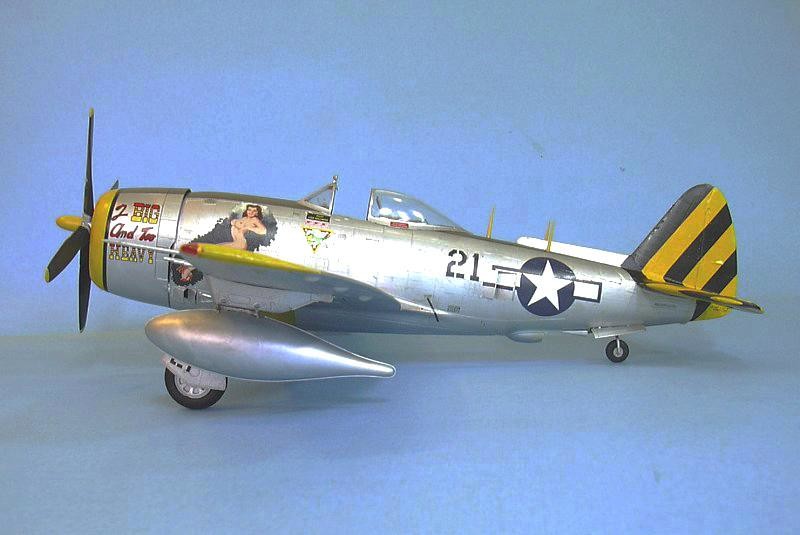
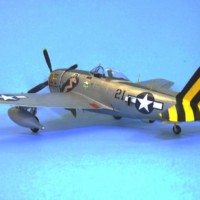
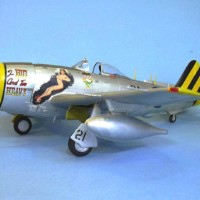
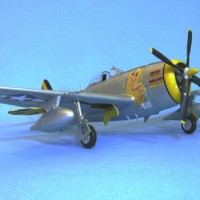
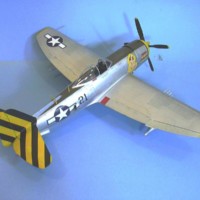
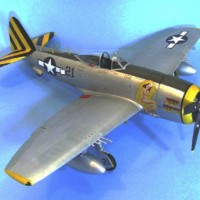
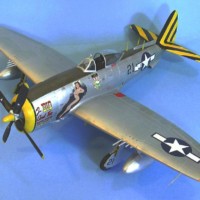
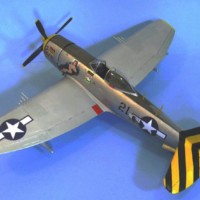
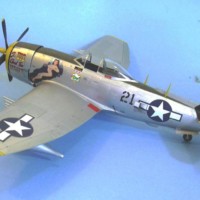
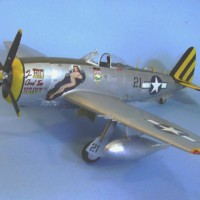
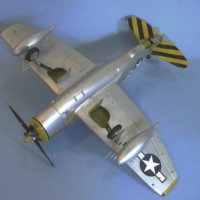

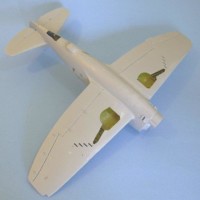
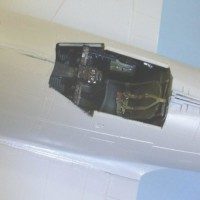
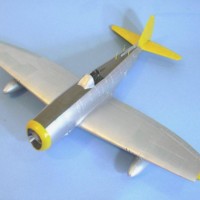
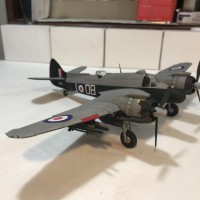
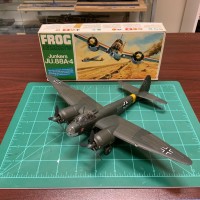
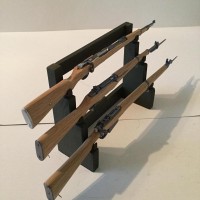
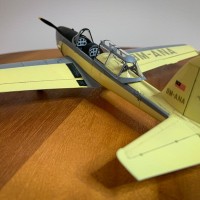
Well done narrative, pics and build, TC...I just love Jugs! 🙂
I have a 1/48 Pro Modeler P-47 N in these markings... but it doesn't look as nice as this one. Great story line too Tom.
Funny I didn't notice the aircraft first,just the decals.but one hell of a build,you must be glad with the finished kit,well done.
Is that Emmanuelle on the cowl? 🙂
As the writer of Emmanuelle V, I can assure3 you you're wrong. 🙂
As someone who already knew that, I can say that's why I asked. I just thought it might be a bit of "artistic license"...nice plane though.
Tom, can I get your autograph?
LOL - I never realized I would end up being the "credited writer." I actually was the supervising producer for it as a TV series, which was then turned into a movie by gluing all the episodes together, and then found I had been given the credit.
Many thanks for excellent story and model.
Well done Tom. Didn't realize that many N models were built. Shoulda, woulda, coulda saved the lives of many P-51 pilots in Korea. Logistics thou art a heartless b***h.
I get angry every time I think of that. The 500 P-47Ns in the ANG would have made all the difference.
Really nice, Tom. May I ask; how many hours in the project and (I've never done a natural metal finish, so...) what metallic paint(s) do you use to get such a subtle, satin appearance?
The model took probably 30 hours 9wasn't keeping track). Like I said, it's pretty easy. I used Talon acrylic metal paint (no longer in production). If I was doing it today, I'd use Vallejo acrulic metal paint.
Nice Jug and the plane's nice too.
:). I see what you did there Robert! And I agree wholeheartedly...:)
Another great build Tom.